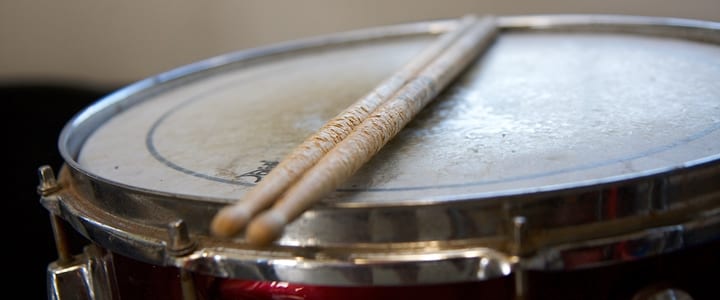 7 Most Important Drum Rudiments
7 Most Important Drum Rudiments
Learning and practicing drum rudiments is essential for all drummers, especially if you’re just starting out.
Mastering basic rudiments will help take your skills to the next level, and in this tutorial, you’ll learn how to play 7 of them. Since these create a foundation, it’s essential to learn them before attempting other rudiments
And, if you want to go ahead and practice, have your drum sticks ready to play along with the how-to video below!
RELATED: The Complete Guide for How to Play the Drums
What are the basic drum rudiments?
The 7 most important drum rudiments you’ll learn how to play in the video below are:
- The single stroke roll,
- multiple bounce (buzz/press) roll,
- double-stroke open roll,
- five stroke roll,
- single paradiddle,
- flam, and
- drag.
Now grab your drum sticks and let’s start practicing these essential rudiments for drum set!
Interested in learning more about the basic drum rudiments for beginners? Continue reading!
Single Stroke Roll
Whether you’re a beginner or a pro, the single stroke roll is absolutely essential to learn because it’s the most commonly played rudiment. Drummers often play this in drum solos, beats, and fills.
The single stroke roll is how you play simple alternating strokes. You’ll practice the same thing with both your left and right hand like this:
- Leading with your right: R L R L
- Leading with your left: L R L R
Multiple Bounce (Buzz/Press) Roll
This essential drum rudiment is often played for marching band and orchestral drumming. The multiple bounce roll, or buzz/press roll, has you play consecutive and alternating multiple bounce strokes. In each stroke, there’s an undefined number of notes. You create these by pushing your stick into the drumhead using some fulcrum pressure.
Double-Stroke Open Roll
This one is similar to the single stroke roll, but a little more challenging. With that said, it helps to learn the single stroke first. Then, with the double-stroke, you’ll play two strokes per hand like this:
Five Stroke Roll
Another essential but fairly easy drum rudiment is the five stroke roll. With your leading hand, start by playing an alternating four-note double stroke roll. Then, finish off with a single stroke as the fifth note. With your other hand, you’ll play this same combo of notes.
Single Paradiddle
The paradiddle combines single and double-stroke drum rudiments. Fun fact: ‘para’ means ‘single stroke and ‘diddle’ means ‘double stroke.’ So, it goes like this:
- Leading with your right: R L R R L R L L
- Leading with your left: L R L L R L R R
Flam
This rudiment is one of the easier ones to learn because you play two strokes just about at the same time. You’ll do this by starting with one drumstick at a lower height while you play a grace note. Then, the other drumstick will strike, playing a primary note.
Drag
Playing the drag rudiment is much like the flam. There are at least two grace notes, followed by a primary stroke. If you use bounce double strokes, you can play the grace notes as two strokes.
How do you learn drum rudiments?
After or while watching the video above and reading a summary on our drum rudiments list, it’s time to practice! Practice these basic rudiments open (slow), close (fast), and back to open. You can also set the playback on the video to a slower speed, so you can follow along at your own pace until you get the hang of it.
*NOTE: There is a tipping point in double strokes that shifts from muscular-control dominant to rebound dominant as the tempo increases, so practice these as prescribed to build more control.
Learn more about reading drum sheet music here.
Why You Should Practice Rudiments for Drum Set
Drum rudiments are like words in a drummer’s vocabulary. In essence, rudiments are drum patterns that you can use for drills or warm-ups or develop into more complex drum beats.
These drum patterns have been fleshed out from the “standard” 26 to the 40 Percussive Arts Society’s Official Drum Rudiments.
So, after you master the 7 in this tutorial, you can have fun learning even more stick-twisting (and oddly-named) hybrid rudiments.
Have Fun Learning These Essential Drum Rudiments!
Drum rudiments are your foundation as a drummer, and all of these rudiments will help you develop finesse. If you want extra help learning these skills or building your confidence, you can always work with a professional drum teacher!
Which rudiments are you going to tackle next? Are there any you find particularly challenging?
Let us know in the comments below!
 Post Author: Tracy D.
Post Author: Tracy D.Tracy D. teaches drum lessons in Edmond, OK, as well as online. She earned her Bachelor’s in Music Education from Oklahoma Christian University and has played with the OKC Community Orchestra since 2009. Learn more about Tracy here!
Photo by Travis Isaacs
Maile Proctor
![7 Most Important Drum Rudiments [With How to Video]](/_next/image?url=https%3A%2F%2Ftakelessons.com%2Fblog%2Fwp-content%2Fuploads%2F2015%2F09%2Fdrum-set-7-essential-drum-rudiments.jpeg&w=3840&q=75)